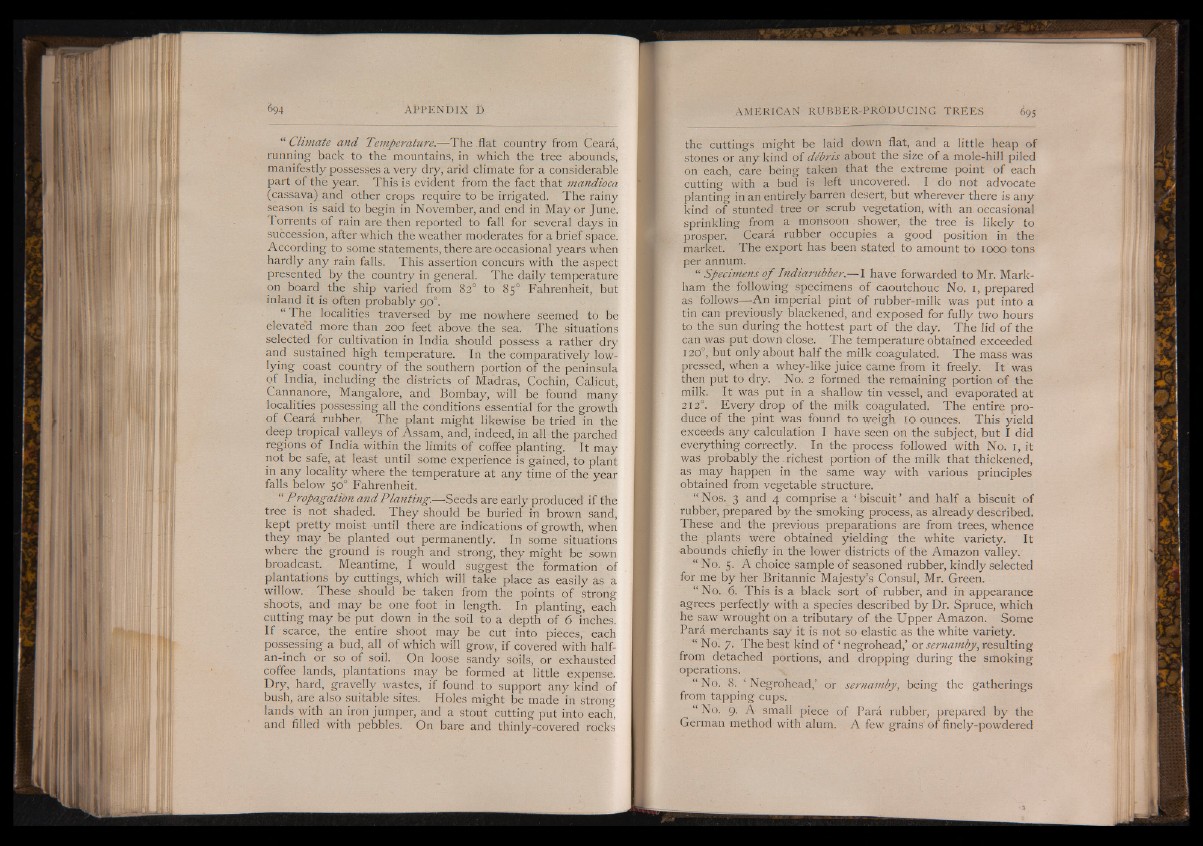
“ Climate and Temperature.— The .flat country from Ceara,
running back to the mountains, in which the tree abounds,
manifestly possesses a very dry, arid climate for a considerable
part of the year. This is evident from the fact that mandioca
(cassava) and other crops require to be irrigated. The rainy
season is said to begin in November, and end in May or June.
Torrents of rain are then reported to fall for several days in
succession, after which the weather moderates for a brief space.
According to some statements, there are-occasional years when
hardly any rain falls. This assertion concurs with the aspect
presented by the country in general. The daily temperature
on board the ship varied from 82° to 850 Fahrenheit, but
inland it is often probably 90°.
“ The localities traversed by me nowhere seemed to be
elevate'd more than 200 feet above- the sea. The situations
selected for cultivation in India should possess a rather dry
and sustained high temperature. In the comparatively low-
lying coast country of the southern portion of the peninsula
of India, including the districts of Madras, Cochin, Calicut,
Cannanore, Mangalore, and Bombay, will be found many
localities possessing all the conditions essential for the growth
of Ceara rubber. The plant might likewise be tried in the
deep tropical valleys of Assam, and, indeed, in all the parched
regions of India within the limits of coffee planting. It may
not be safe, at least until some experience is gained, to plant
in any locality where the temperature at any time of the year
falls below 50° Fahrenheit.
“ Propagation and Planting.— Seeds are early produced if the
tree is not shaded. They should be buried in brown sand,
kept pretty moist until there are indications of growth, when
they may be planted out permanently. In some situations
where the ground is rough and strong, they might be sown
broadcast. Meantime, I would suggest the formation of
plantations by cuttings, which will take place as easily as a
willow. These should be taken from the points of strong
shoots, and may be one foot in length. In planting, each
cutting may be put down in the soil to a depth of 6 inches.
I f scarce, the entire shoot may be cut into pieces, each
possessing a bud, all of which will grow, if covered with half-
an-inch or so of soil. On loose sandy soils, or exhausted
coffee lands, plantations may be formed at little expense.
Dry, hard, gravelly wastes, if found to support any kind of
bush, are also suitable sites. Holes might be made in strong
lands with an iron jumper, and a stout cutting put into each,
and filled with pebbles. On bare and thinly-covered rocks
the cuttings might be laid down flat, and a little heap of
stones or any kind of debris about the size of a mole-hill piled
on each, care being taken that the extreme point of each
cutting with a bud is left uncovered. I do not advocate
planting in an entirely barren desert, but wherever there is any
kind of stunted tree or scrub vegetation, with an occasional
sprinkling from a monsoon shower, the tree is likely to
prosper, Ceara rubber occupies a good position in the
market. The export has been stated to amount to 1000 tons
• per annum.
“ Specimens o f Indiarubber.— I have forwarded to Mr. Markham
the following specimens of caoutchouc No. 1, prepared
as follows— An imperial pint of rubber-milk was put into a
tin can previously blackened, and exposed for fully two hours
to the sun during the hottest part of the day. The lid of the
can was put down close. The temperature obtained exceeded
120°, but only about half the milk coagulated. The mass was
pressed, when a whey-like juice came from it freely. It was
then put to dry. No. 2 formed the remaining portion of the
milk. It was put in a shallow tin vessel, and evaporated at
2120. Every drop of the milk coagulated. The entire produce
of the pint was found to weigh 10 ounces. This yield
exceeds any calculation I have seen on the subject, but I did
everything correctly. In the process followed with No. 1, it
was probably the .richest portion of the milk that thickened,
as may happen in the same way with various principles
obtained from vegetable structure.
“ Nos. 3 and 4 comprise a ‘ biscuit’ and half a biscuit of
rubber, prepared by the smoking process, as already described.
These and the previous preparations are from trees, whence
the plants were obtained yielding the white variety. It
abounds chiefly in the lower districts of the Amazon valley.
1 No. 5. A choice sample of seasoned rubber, kindly selected
for me by her Britannic Majesty’s Consul, Mr. Green.
“ No. 6. This is a black sort of rubber, and in appearance
agrees perfectly with a species described by Dr. Spruce, which
he saw wrought on a tributary of the Upper Amazon. Some
Para merchants say it is not so elastic as the white variety.
“ No. 7. The best kind of ‘ negrohead,’ or sernainby> resulting
from detached portions, and dropping during the smoking
operations.
“ No. 8. ‘ Negrohead,’ or sernamby, being the gatherings
from tapping cups.
“ No. 9. A small piece of Para rubber, prepared by the
German method with alum. A few grains' of finely-powdered
*